Storm Thorgerson
Our interview with the album cover designer behind some of the most memorable images in music



Storm Thorgerson is undoubtedly the man who made album covers a veritable artistic force. Working with bands like Pink Floyd (who gave him his start), Biffy Clyro, The Mars Volta, Muse and so many more, Thorgerson himself is as legendary as the musicians whose work he visually interprets—and for good reason. A master of his craft, he continues to leave both bands’ and fans’ mouths aghast with his visually arresting pictorials, which creatively toe the line between fantasy and reality.
Upon the recent release of A Foot In The Door—a best-of Pink Floyd album featuring remastered recordings of the original songs—we sat down with the iconic British artist to learn more about his own greatest hits, and how he views his own body of work to date.
Can you elaborate on the new cover for A Foot In The Door?
It’s a real floor that we made, and that’s a real man walking across it and the shadow is real. We made the floor specially for this. The tiles are made with what’s called tongue and groove, over a civilized piece of wood, to indicate the gap between the tiles. The pictures are stuck as photographs and then sealed with a varnish, and then it’s all distressed to make it look a bit older. It was very heavy and after we finished it we destroyed it, because there was nowhere to put it.
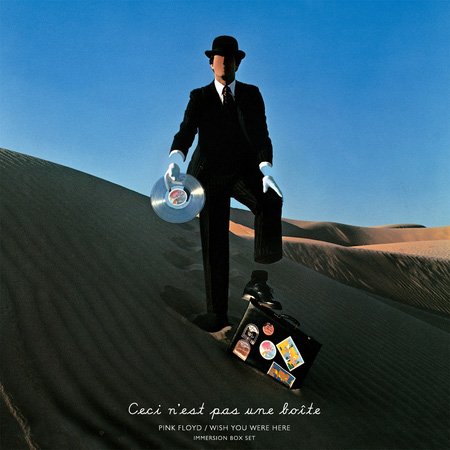
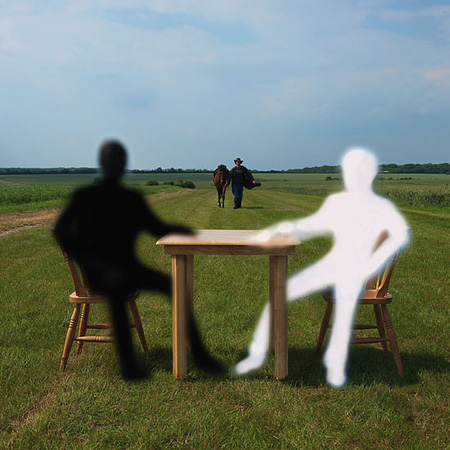
Do you consider yourself a surrealist?
No. The things we do are real, not surreal. All the things we do, we don’t do on the computer. We build sculptures, we do stunts, we hold events—it’s all done for real, about 95% of it anyway is all very real. They may be a bit odd, sometimes they’re a bit contrary, but I don’t feel like a surrealist myself.
I’m not particularly interested in dreams or things that couldn’t go together naturally a bit. It’s difficult to comment on my own work. I mean mostly I think my work is crap, but that’s probably an over paranoid view. I just tend to like it or dislike it, but I don’t think I’m a surrealist. I like the real, but with a twist, but not much of a twist. I don’t like anything too blatant really, I like humor a lot. We like to make funny pictures if we can.
I think that our work is sometimes elegant, sometimes funny, sometimes contrary, juxtaposed. I would hope that it’s optimistic because that’s how I feel.
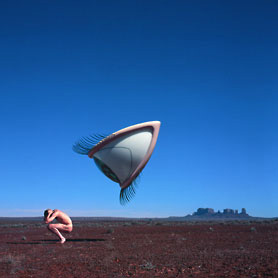
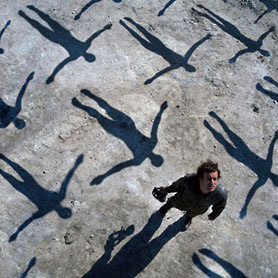
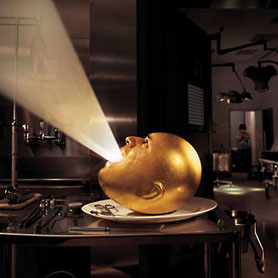
In interviews, you talk a lot about when musicians are “in the groove.” Do you ever feel this way about your work?
Yeah I suppose I probably would. This is an expression they use to denote when they’re feeling very much in the music zone. They’re becoming at one with the music, playing the best they can, and they’re very in tune with the tune. I think this is a word that they use to denote being immersed in the music. So I wouldn’t use the same words, but there are times when I feel that.
Like with Wish You Were Here, we spent a long time with what theme, what undercurrent there was to the album, which took about five weeks because they didn’t know what the album was about, and I know I certainly didn’t. I think we slowly uncovered—not a concept—but an undercurrent. Something thrown underneath the music but is informing it. Once I found that, or once they told me what it was (I guess we found it together), the rest of it visually, came into place very easily. But it took a long time to get there.
So the “in the groove thing” does happen with me, but it just doesn’t happen very quickly. Sometimes I might have an immediate thought but rarely, mostly it takes a lot of time for the music to kind of sync into me. And when it starts to gel, at that point I would say I was in the groove, but I wouldn’t use that term. I don’t know what I would say, but I think it would be a similar sense: I had a really good idea of what to do and I felt immersed in it. I work pretty closely with musicians because I’m only interested in trying to represent the music visually. The music is the starting point, not always, but nearly always.
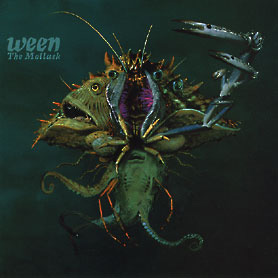
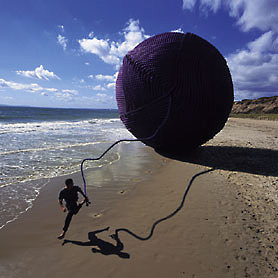
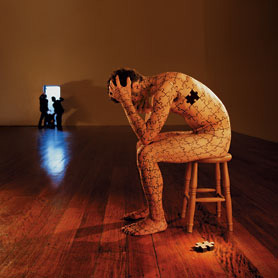
Have you ever done a cover where you didn’t care for the band or the music?
I think I always care about it. I mean, do I like it? If you think about it, it would be impossible for me to like all the music that I’m ever given. But what I do, is I certainly respect it. I don’t think that it has much bearing really because I don’t think it’s my job to like it. I mean if you were a Pink Floyd fan or a Muse fan or a Mars Volta fan, I don’t think you’d care whether the designer liked the music or not because you know you do. If you’re a fan, you don’t care who likes it or dislikes it if you like it. I don’t think they’re interested in my view of the music. What they’re interested, hopefully, is in my interpretation of music to visual, or my translation from one medium to another.
How many album covers have you done?
Oh don’t ask me that. That’s like asking me how old I am, not a fair question. Probably about 300, I don’t really keep count. I’m privileged to work with music, so I’m happy to work, and we work with all kind of different sorts of music. We work with bands from different countries, different ages, different genres, and mostly it’s just really stimulating. I like my job. So, in that sense, as long as I can keep working, and paying the rent as they call it over in England, then I’m relatively happy.

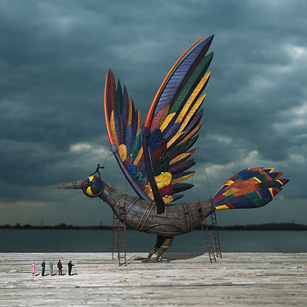
You studied film in school?
Yes. I think there’s quite a filmic influence on my work, but I’m not particularly conscious of it. In a way, I think all artists have all sorts of unconscious drives, admittedly they don’t know what they are. Or interests, or preoccupations. I think if you were to go through my work, over the years you’d find that I was probably very interested in things like birds, or water or trees. I’m not sure what it means, and I don’t really care very much what it might mean. They’re things that I like, they’re things that I come back to every now and then. I think that’s just very typical of all artists whatever their medium. Artists are sort of, preoccupied, and often those sorts of things reappear in their work.
Are you concerned with technology and cameras or is your main focus the overall picture?
I think we use a Pulsar back on a Hasselblad body. I’m concerned with the technology, whether it was 35mm, whether it was digital or film, I’m concerned with it in a sense. The thing that I do, it’s a performance in some strange place that nobody can get to. So if I didn’t take a picture of it, you would never see it and the band would never see it. And if the band never saw it they may wonder where their cover is, you see. So I have to take the picture. The technology is very important but I hire a good friend to do it. He’s called Rupert, he’s been working with me now for about 15 years. He’s probably sick to death of me actually but he’s still there. It’s his responsibility and if he makes a mistake we kill him. It’s very straightforward.
How do you see the album cover in today’s digital world?
Well I suspect the album cover has a rather short life in some way, although I hear vinyl is making a comeback. I think that music and visual will always invite togetherness. Whether it’s a t-shirt, whether it’s a poster, whether it’s something on the computer, whether it’s a CD or vinyl. Whether it’s an advert on TV or a billboard. Somehow it feels quite natural to do it. All things come to pass, I suspect. In England it’s very popular to do the box set and visually speaking I’m ok with that. I think there’s always a place for visual and music, for the two art forms to coexist. Album covers or CDs may be a dying breed yes, but les choses changent. Things change.











